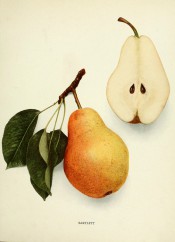Pyrus communis ‘Williams’ Bonchrétien’
‘Fruit pretty large, of an irregular, pyramidal, and somewhat truncated form, from three to four inches long, and from two to three inches in diameter. Eye seated on the summit, and never in a hollow or cavity, as in other varieties called Bonchrétien. Stalk an inch long, very gross and fleshy. Skin pale green, mottled all over with a mixture of darker green and russet brown, becoming yellowish and tinged with red on the sunny side when fully ripe. Flesh whitish, very tender and delicate, abounding with a sweet and agreeably perfumed juice. Ripe the end of August to the middle of September.’ [George Lindley – Orchard Guide p.350/1831].
Horticultural & Botanical History
‘This pear was found as a wilding by a Mr. Stair, a schoolmaster at Aldermaston, Berkshire, England. From him it was acquired by a Mr. Williams, a nurseryman at Turnham Green, Middlesex, and as it was propagated and distributed by him it became known by his name, although it is still known as Stair's pear at Aldermaston. It was brought to this country [USA] in 1797 or 1799 by James Carter of Boston for Thomas Brewer who planted the variety in his grounds at Roxbury, Massachusetts, under the name of Williams' Bon Chretien, by which name it was then and still is known both in England and France. In 1817 Enoch Bartlett, Dorchester, Massachusetts, became possessed of the Brewer estate, and not knowing its true name allowed the pear to go out under his own. Henceforth it was known in America as Bartlett. The American Pomological Society added this variety to its catalog-list of fruits in 1848.’ [Pears of New York p.124].
An alternative originator is given by George Lindley. ‘This Pear appears to have sprung up from seed in the garden of Mr. Wheeler, a schoolmaster at Aldermaston, in Berkshire, previously to 1770, as it was then a very young plant. An account of it was published by the Horticultural Society, as above, in 1816, at which time the garden in which the tree grew was in the possession of Wm. Congreve, Esq.’ [George Lindley – Orchard Guide p.350/1831].
Figured also in the Herefordshire Pomona [HP pl.IX/1878] and Le Jardin Fruitier du Muséum [JFM, vol.2/1859].
History at Camden Park
Listed in the 1850 and 1857 catalogues [Pear no.28/1850]. In his Diary Macarthur expresses doubt about this pear, suggesting that it may be Beurré Gris Mourceau. [Diary B, MP A2951/1862].
Notes
Published May 19, 2010 - 12:24 AM | Last updated Jul 22, 2011 - 04:10 AM
| Family | Rosaceae |
|---|---|
| Category | |
| Region of origin | Garden origin, England |
| Synonyms |
|
| Common Name | Dessert Pear, summer to early autumn |
| Name in the Camden Park Record |
Williams Bon Chrétien
|
| Confidence level | medium |


